Osteoarthritis (OA) is the most common form of arthritis, and it is due to cartilage destruction and changes in the subchondral bone. The risk of developing this disorder increases with age, obesity, and repetitive joint use or trauma. Patients develop gradual joint pain, stiffness lasting < 30 minutes, and decreased range of motion. Physical exam may reveal crepitus with joint motion and osteophyte formation (Heberden and Bouchard nodes). The diagnosis is clinical and supported by radiographic joint findings. Management includes conservative measures, analgesic medications, glucocorticoid intra-articular injections, and surgery for advanced disease.
Last updated: Apr 12, 2024
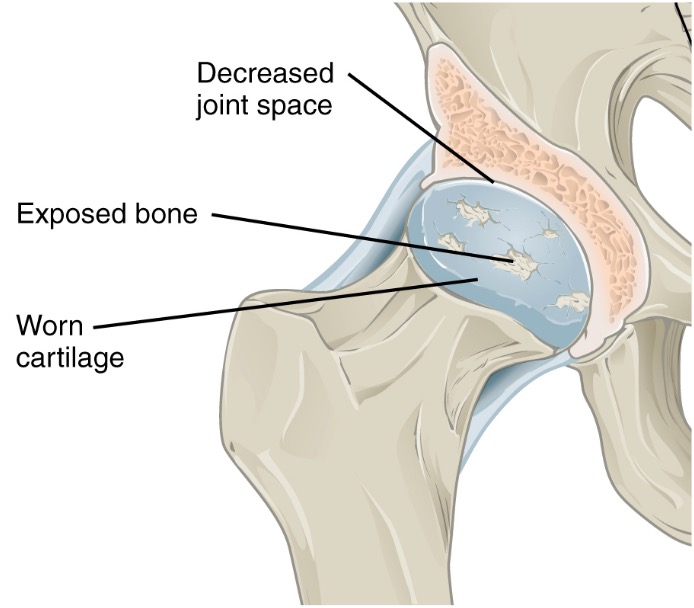
Pathology of osteoarthritis
Destruction of cartilage leads to decreased joint space. With severe destruction, bone becomes denuded.

Stages of osteoarthritis of the knee joint:
A. There is minimal disruption and approximately 10% cartilage loss.
B. Narrowing of the joint space is seen, cartilage begins to break down, and osteophytes develop.
C. There is moderate reduction of the joint space. Gaps in the cartilage can expand until the bone is reached.
D. The joint space is greatly reduced and approximately 60% of the cartilage is lost. Large osteophytes are seen.
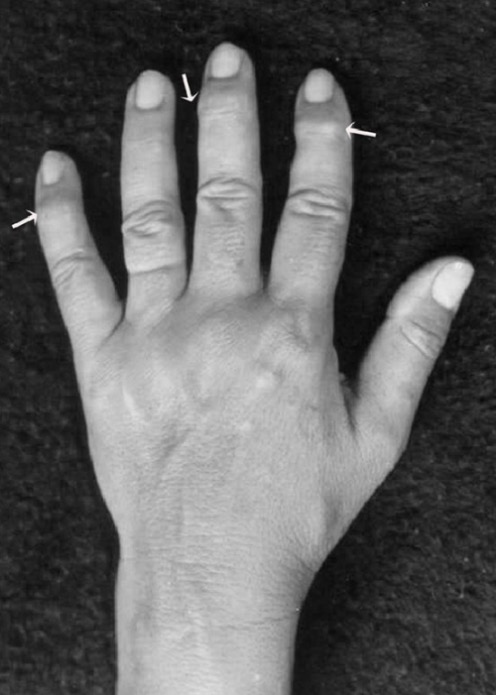
Heberden’s nodes in osteoarthritis: bony growth spurs at the DIP joints due to osteophytes
Image: “Bony growth spurts” by School of Dentistry, Franciscan University Center, Andradas Street, 1614, 97010-032 Santa Maria, RS, Brazil. License: CC BY 3.0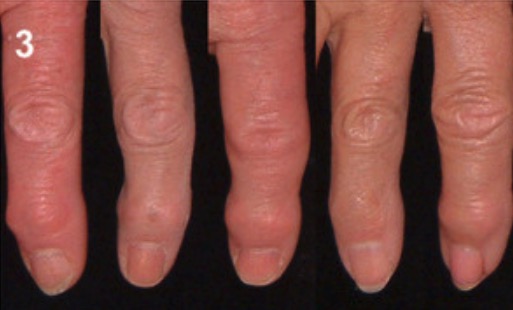
Bouchard’s nodes in osteoarthritis: osteophytes of the PIP joints
Image: “Grading of osteoarthritis” by Landspitalinn University Hospital, University of Iceland, IS-108 Fossvogur, Reykjavik, ICELAND. License: CC BY 2.0, edited by Lecturio.Osteoarthritis Osteoarthritis Osteoarthritis (OA) is the most common form of arthritis, and is due to cartilage destruction and changes of the subchondral bone. The risk of developing this disorder increases with age, obesity, and repetitive joint use or trauma. Patients develop gradual joint pain, stiffness lasting < 30 minutes, and decreased range of motion. Osteoarthritis is a clinical diagnosis that is confirmed with imaging. Imaging is not routinely required but may be needed to diagnose atypical presentations of osteoarthritis Osteoarthritis Osteoarthritis (OA) is the most common form of arthritis, and is due to cartilage destruction and changes of the subchondral bone. The risk of developing this disorder increases with age, obesity, and repetitive joint use or trauma. Patients develop gradual joint pain, stiffness lasting < 30 minutes, and decreased range of motion. Osteoarthritis, such as morning joint-related stiffness > 30 minutes, rapid progression of symptoms, recent trauma, hot swollen joint, or history suggestive of infection or malignancy Malignancy Hemothorax.[8,9]
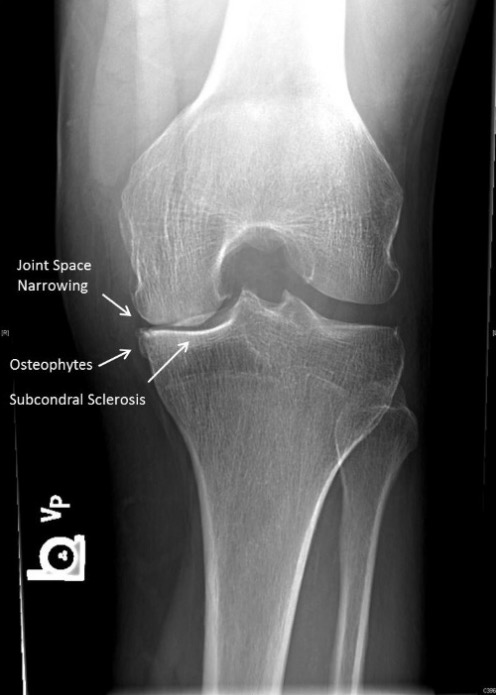
Radiographic features of osteoarthritis: This image shows joint space narrowing, osteophytes, and subchondral sclerosis (arrows).
Image: “Examples of JSN” by Center for Hip and Knee Replacement (CHKR), Department of Orthopaedic Surgery, NewYork-Presbyterian Hospital, Columbia University Medical Center, 622 W. 168th Street, PH 1155, New York, NY 10032, USA. License: CC BY 4.0
Radiographic features of osteoarthritis: Close-up imaging shows a subchondral cyst on distal clavicle. This signals osteoarthritis of the acromioclavicular joint.
Image: “Case presentation” by Department of Orthopaedic Surgery, Japanese Red Cross Sendai Hospital, Yagiyama Honcyo, Taihaku-Ku, Sendai, Miyagi, Japan. License: CC BY 2.5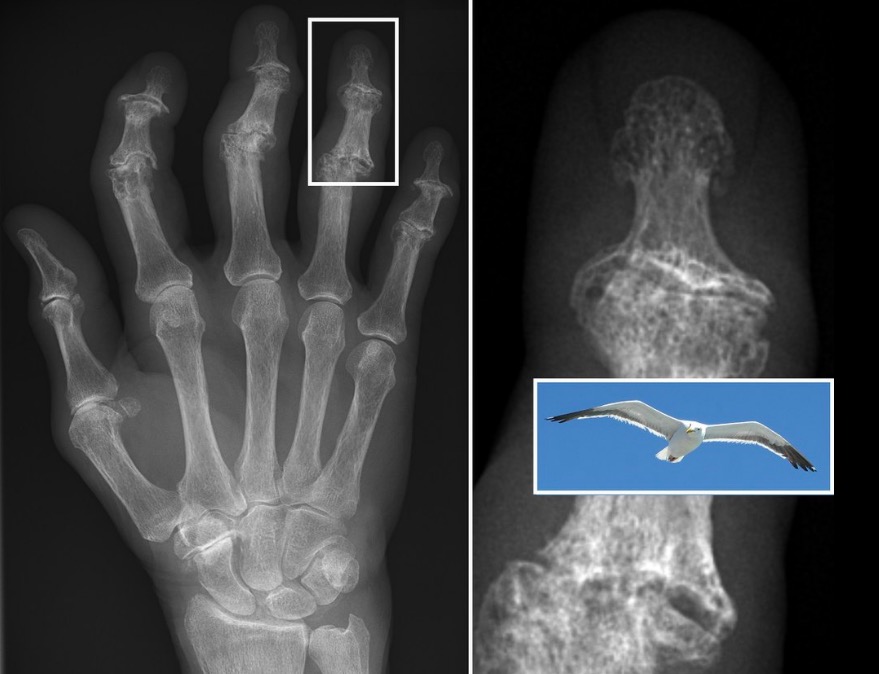
Radiographic features of erosive osteoarthritis: Central subchondral erosions give the DIP joint a “seagull wing” appearance.
Image: “X-ray of erosive osteoarthritis of the fingers” by Rennett Stowe and Mikael Häggström . License: CC BY 4.0The following tests are not used for the diagnosis of OA OA Osteoarthritis (OA) is the most common form of arthritis, and is due to cartilage destruction and changes of the subchondral bone. The risk of developing this disorder increases with age, obesity, and repetitive joint use or trauma. Patients develop gradual joint pain, stiffness lasting < 30 minutes, and decreased range of motion. Osteoarthritis, but are used to exclude other causes of arthritis Arthritis Acute or chronic inflammation of joints. Osteoarthritis.
The goals of management include alleviating pain Pain An unpleasant sensation induced by noxious stimuli which are detected by nerve endings of nociceptive neurons. Pain: Types and Pathways and minimizing the loss of physical function. Therapy is individualized and different methods are used. The following recommendations are based on US, UK, and international guidelines.

Osteoarthritis management flowchart
Patients start with conservative measures (weight loss and physical therapy). If symptoms do not improve, or if they worsen, management progresses through this flowchart. Surgery is reserved for patients with severe, unrelenting disease.
Initial assessment:[14,15]
Core approaches (all patients Patients Individuals participating in the health care system for the purpose of receiving therapeutic, diagnostic, or preventive procedures. Clinician–Patient Relationship):[13‒15]
Initial medical management:
2nd-line medical therapy:[13‒16]
Important pharmacotherapy considerations